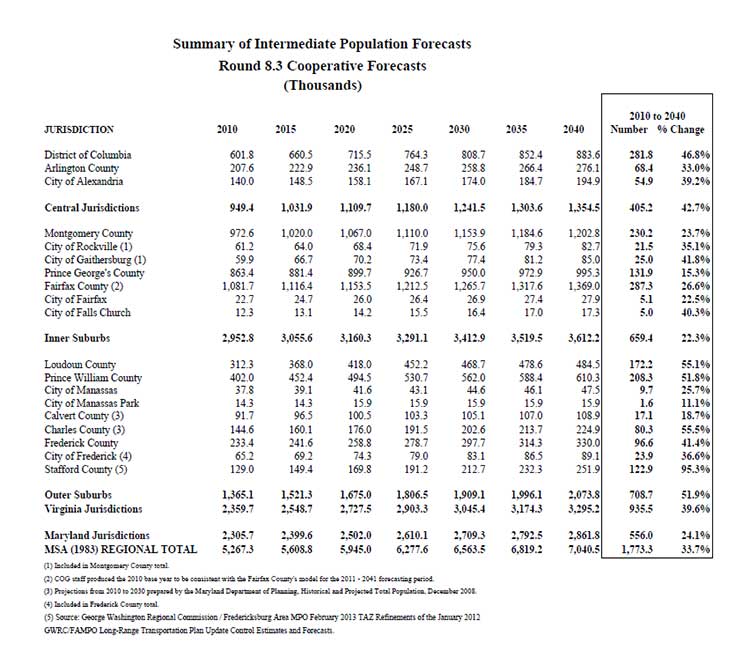Growth. It’s one of the region’s most important issues so it’s not surprising that it was once again front-and-center at the March 2014 COG Board of Directors meeting. Area leaders approved a new round of long-range forecasts discussed economic trends with one of the region’s leading experts and kicked off a new information and policy series on the infrastructure needed to support and sustain the coming people and jobs.
The Board approved the Round 8.3 Cooperative Forecasts which project an additional 1.6 million residents between 2010 and 2040—the equivalent of adding Philadelphia’s population to metropolitan Washington. The forecasts also project 1.3 million additional jobs over this time period.

(Regional figures subtract Calvert and Stafford counties who while part of the Metropolitan Statistical Area are not members of the Council of Governments.)
In a presentation to the COG Board District of Columbia Interim Planning Director Rosalynn Hughey who serves as COG Planning Directors Committee Chair noted the main change between this year’s forecast and last year’s version is an uptick in the District’s population projections. The newly-approved regional forecasts now show that by 2040 D.C. will have 883000 residents—about 112000 more than the figure in last year’s forecast.
The forecasts continue to show the region’s inner suburbs like Fairfax Montgomery and Prince George’s counties will have the majority of employment and population in 2040 while outer suburbs will grow at the fastest rate. For example Prince William County is expected to double its total jobs between 2010 and 2040.
For almost four decades area governments and agencies have used COG’s forecasts to inform their transportation housing and environmental planning. The forecasts are developed with local governments and are based on short-term permitting activity and site plans and long-term projections on places zoned for growth.
Following the discussion on forecasts George Mason University’s Dr. Stephen Fuller gave a presentation on the region’s economic outlook and stressed that the next five years were a critical time for governments to shape the trajectory of the coming growth. Fuller specifically urged leaders to focus on housing and workforce development noting the region needs to produce much more housing to meet future demand and better prepare workers for high-growth sectors.
Several COG Board members also noted the need to better coordinate land use and transportation and referenced COG’s Place Opportunity and the TPB’s Priorities Plan. Both recently-released reports offer strategies to help decision-makers accommodate growth in the region’s business and residential hubs known as Activity Centers.
Closely related to the discussions on growth COG Executive Director Chuck Bean and Senior Director Stuart Freudberg briefed the Board on a new 2014 infrastructure initiative. The series will focus on COG’s main areas of expertise such as transportation water energy and public safety communications. For example in April the Board will focus on drinking water and water security learning about the complex network of suppliers distributors and financial costs to operate the systems. Officials hope the series will identify policy advocacy and outreach actions around key regional infrastructure needs.
Cooperative forecasts Place Opportunity the TPB Priorities Plan and the regional infrastructure series… All of these initiatives show how area leaders are focusing on the big picture of growth and the strategies and policies needed to shape a better future and achieve our Region Forward vision.